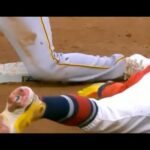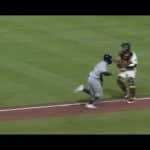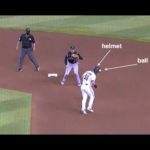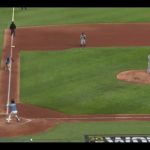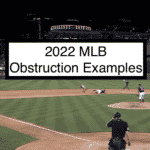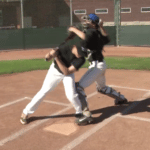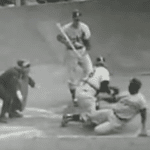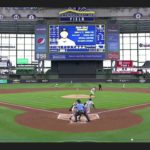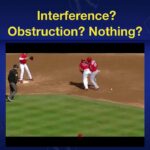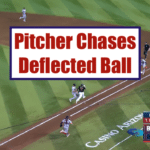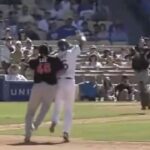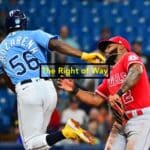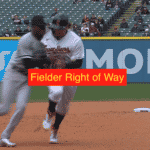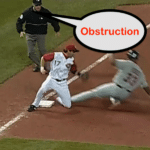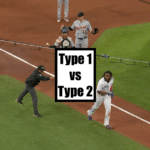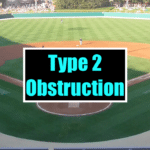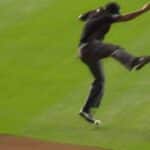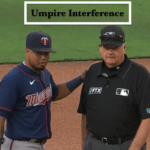OBSTRUCTION AND INTERFERENCE PLAYS— APPROVED RULINGS
Rules 6.01(h)(1), 6.01(h)(2), 6.01, 5.02(c):
(1) Runner on first base; batter-runner gets in rundown between home and first. Can obstruction be called going back to home?
Ruling: No, unless the obstruction is intentional.
NOTE: In situations where the batter-runner gets in a rundown between first and home, if the batter-runner retreats and reaches home plate, the batter-runner shall be declared out.
(2) Batter-runner is obstructed before reaching first base with no play being made on him (for example, on a ball hit to the outfield).
Ruling: Call the obstruction by pointing at the infraction and calling, “That’s obstruction”; however, leave the ball in play until the play is over. Then impose such penalties, if any, that will nullify the act of obstruction. If fly ball is caught in this situation, the batter-runner is out. If the batted ball was a fair ball not caught, the batter-runner will always be “protected” at least to first base.
(3) Runner is on second base when the batter-runner is obstructed after reaching first base. The umpire intends to award the batter-runner second base on the obstruction. What happens to the runner on second?
Ruling: Runner on second is awarded third base.
(4) With the bases loaded, batter hits a sharp ground ball that deflects off of the shortstop and starts to roll away from him. As the shortstop starts to go after the ball, the runner from second collides with the shortstop.
Ruling: After the ball deflects off the shortstop, if the ball is within the fielder’s immediate reach, the runner must avoid the fielder, and if contact occurs under those circumstances, interference shall be called and the runner declared out. (In this situation the fielder is still considered “in the act of fielding” the ball and has not “missed” as described in the Comment to Official Baseball Rule 6.01(h).) However, if the ball is not within reach of the fielder after it deflects off the fielder (i.e., the fielder must chase after the ball), the fielder must then avoid the runner, and if contact occurs under those circumstances, obstruction shall be called under Official Baseball Rule 6.01(h)(2).
(5) With a runner on first base, the batter hits a line drive back to the pitcher that deflects off of the pitcher’s glove and rolls towards the second baseman. As the second baseman is attempting to field the ball, the runner from first collides with the second baseman.
Ruling: In the judgment of the umpire, if the second baseman has a legitimate play on the ball, the runner from first is called out for interference. The ball is dead at the moment of interference, and the batter-runner is placed at first base (provided the interference was not intentional; if intentional, both runner and batter-runner are declared out). However, if the umpire rules that the second baseman does not have a legitimate play on the ball (i.e., the second baseman was merely moving in the direction of a loose ball), then obstruction is called under Official Baseball Rule 6.01(h)(2).
(6) Runner on first base, no one out. On a hit-and-run play, the batter hits a fair ball down the right-field line. In rounding second base and heading for third, the runner from first collides with the shortstop and falls down. Because of the collision, the runner is not able to advance to third base and returns to second as the ball is being thrown back to the infield. Had the runner not collided with the shortstop, the runner would have easily advanced to third base.
Ruling: Obstruction is called when the collision occurs, but the ball remains in play because no play was being made on the obstructed runner at the moment such runner was obstructed. “Time” is called when all action has ceased, and the obstructed runner is awarded third base because that is the base such runner would have reached had no obstruction occurred. The batter-runner would also be placed at the base such batter-runner would have reached had no obstruction occurred (either first or second, depending on the umpire’s judgment).
NOTE: In this play, if the runner from first had been thrown out going back into second base, the umpire would call “Time” the moment the runner is tagged out. The obstructed runner would then be awarded third base (assuming that is the base such runner would have reached had no obstruction occurred), and the batter-runner would also be placed at the base the batter-runner would have reached, in the umpire’s judgment, had no obstruction occurred.
(7) Batter hits a ground ball or pop-up between home and first base that the pitcher and first baseman both attempt to field. Batter-runner makes contact with one or both fielders in running to first base.
Ruling: Under Official Baseball Rule 6.01(a)(10), if two or more fielders at –
tempt to field a batted ball, and the runner comes in contact with one or more of
them, the umpire shall determine which fielder is entitled to the benefit of the interference rule, and shall NOT declare the runner out for coming in contact with a
fielder other than the one the umpire determines to be entitled to field such a ball.
It is therefore possible for the umpire to make either an interference or obstruction
call on this play based upon the umpire’s determination as to which fielder was
entitled to field the batted ball. If the runner makes contact with a fielder other
than the one the umpire determines to be entitled to field the ball, such a fielder
has very likely obstructed the runner.
(8) Runner on second base, no outs. Pitcher attempts a pickoff at second, and the runner gets in a rundown between second and third. During the rundown, the runner is obstructed by the third baseman while a throw is in flight from the shortstop. The shortstop’s throw is wild and goes into the dugout.
Ruling: The runner is awarded home (two bases from the runner’s position at the time of the throw). The runner was obstructed while a play was being made on him (“Type 1” obstruction), and the umpire should call “Time” at the moment the obstruction occurs. However, under the Comment to Official Baseball Rule 6.01(h)(1), if a thrown ball is in flight before the obstruction is called by the umpire, runners shall be awarded such bases on wild throws as they would have been awarded had no obstruction occurred. Therefore, even though the runner was obstructed while a play was being made on him, in this situation the runner is awarded two bases from the time of the throw (and not the customary “at least one base beyond the base he last legally touched before the obstruction”).
(9) Runner on first base, no outs. Ground ball up the first-base line. First
baseman picks up the ball and throws to second base for a force out. After the out
at second, the batter-runner is obstructed by the pitcher.
Ruling: “Time” is called and the batter-runner is awarded first base. The out
at second base stands.
(10) Runner on first base, two outs. Batter hits a fair ball into the right-field corner. Right fielder throws to second to retire the batter-runner, who is advancing on the play. The throw is off-target and goes into left field. The batter-runner gets up and attempts to advance. The shortstop starts chasing after the ball and runs into the batter-runner. The batter-runner continues to advance and is thrown out on a close play at the plate.
Ruling: Obstruction is called when the contact occurs between the shortstop and the batter-runner. Play is allowed to continue because no play is being made on the runner at the moment such runner is obstructed. After the runner is out at home, if the umpires deem that the runner would have scored had such runner not been obstructed (i.e., the obstruction caused the runner to be out), “Time” is called and the batter-runner awarded home.
(11) Runner on third base, one out. Batter hits a fly ball to right-center field, and the runner goes back to third base to tag up. Third baseman approaches the runner, faces him, and jockeys back and forth, intentionally trying to block the runner’s view of the fielder catching the ball.
Ruling: This is obstruction under Official Baseball Rule 6.01(h)(2). The umpire should call the infraction when it occurs and award bases, if any, in the appropriate manner.
(12) With a runner on first base, the first baseman—rather than holding the runner in the traditional manner—jockeys back and forth in front of the runner, several feet to the second base side of the bag. In the umpire’s judgment the first baseman is doing this intentionally to block the runner’s view of the pitcher.
Ruling: While Official Baseball Rule 5.02(c) allows a fielder to position himself anywhere in fair territory, if the umpire deems the fielder’s actions are a deliberate effort to block the runner’s view of the pitcher, it is illegal and clearly not within the spirit of the Rules. The first baseman should be warned to stop, and if he persists, he is subject to ejection.
(13) Runner on first base is stealing, no outs, no count on the batter. Pitcher pitches out. Batter, observing the pitch-out, intentionally throws his bat at the catcher in a feigned swing, and the bat strikes the catcher as he is catching the pitch or attempting to throw. Batter remains in the batter’s box during this time.
Ruling: Interference. Batter is declared out unless the catcher’s initial throw retires the runner, in which case the play stands.
(14) Runner on first base is stealing, three balls on the batter. The next pitch is a check-swing that the plate umpire initially rules a ball. The batter-runner takes off for first base and in so doing interferes (out of the batter’s box) with the catcher’s throw to retire the runner attempting to reach second. Runner is safe at second. An appeal is made to the base umpire regarding the check-swing, and the base umpire rules a swing.
Ruling: Batter’s interference. Batter is declared out and runner returns to first base. Note that if this situation occurred with two strikes on the batter, then both the batter and runner are declared out. (See the last paragraph of Interpretation #66.)

